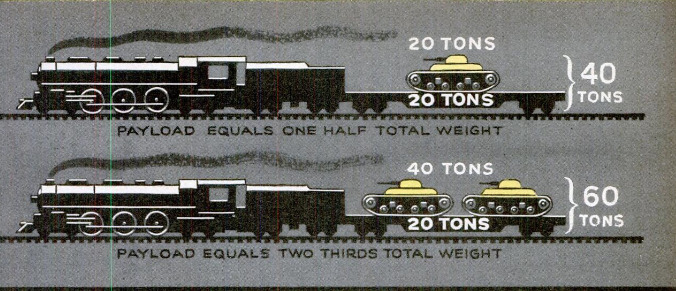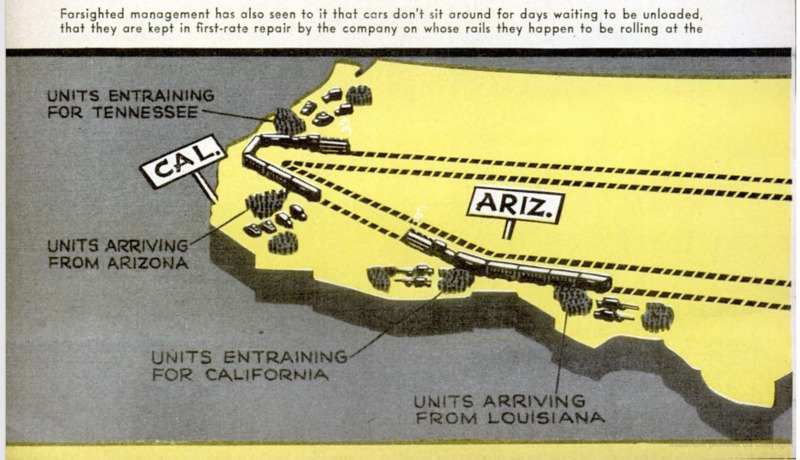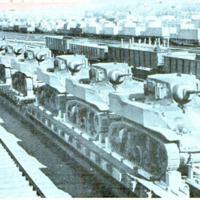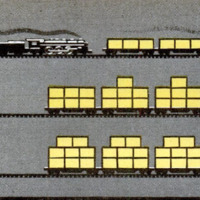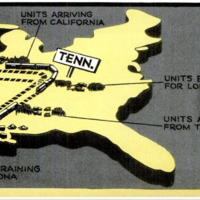-
Title (Dublin Core)
-
The Iron Horse Saves the Day
-
Article Title and/or Image Caption (Dublin Core)
-
The Iron Horse Saves the Day
-
extracted text (Extract Text)
-
TALK all you want about airplanes
and electronics and motor transport
—the part of this war effort which really
rates a shout of amazement is the role
played by the American railroads. The
iron horse, which plowed the plains and
spanned the mountains, was not what he
used to be. For the last 20 years he had
been getting creaky at the joints. To
this Buck Rogers generation, millions of
whom had never even ridden on a train,
it seemed that he was inevitably doomed
to go out to pasture. But here is the old
horse now, snorting in the traces, haul-
ing bigger loads and faster than anyone
dreamed possible—Ileast of all the rail-
road men who are making him do it.
With fewer miles of road than they
had in 1918, with fewer employees, with
20,000 fewer locomotives and 600,000
fewer freight cars, the railroads of
America in 1942 moved two thirds more
ton-miles of freight than in 1918, and
in 1943 are moving twice as much. In
the first three months of this year, their
passenger traffic, which had slumped off
to a trickle in the 1930’s, was virtually
double what it was in the corresponding
period of 1918. And this, mind you, is
the accomplishment of a transportation
system which in 1918 was almost at
its peak and for two decades after that
had been taking it on the chin from the
truck and bus competition of the motor age.
‘We Americans of the motor age, indeed,
have only God and the railroads to thank
for the fact that we avoided national disaster
in 1942. Pearl Harbor was bad enough, but
when the U-boat packs fell upon our de-
fenseless oil tankers on the eastern seaboard,
they were striking much closer to the actual
vitals of the country. The whole industrial
Northeast was dependent on gasoline, and
the devastating success of the submarine
was cutting off that supply.
It was the railroads that came to the
rescue and averted the collapse of motor
transport. A fleet of 70,000 old tank cars—
used by the oil companies for odd jobs of
storage and short hauling—were put to
work, hitched into solid trains, and shuttled
back and forth across the country on fast
daily schedules as precise as passenger serv-
ice. Railroad men had been laughed at
when they first thought they might be able
to move 200,000 barrels a day in this fashion,
and soon it was proved how wrong they
were. For by this last summer the old tank
cars—stopping occasionally to get new wheels
—were moving five times that much!
The East still starved for gas. But that
was because the railroads had been so suc-
cessful that the Army and Navy dared to
draw on eastern gas for their fighting supply.
While this battle of oil was being won, the
loss of Malay rubber to Japan threw another
great burden on the rails. We have man-
aged to get by on our tire supply, because
railways have absorbed the great expansion
of traffic that would have been on rubber.
Transportation is a fundamental necessity
in any war. Sea transport, because it is
under attack, and air transport, because it is
new, have had the spotlight; but the rail-
roads have handled a far heavier load, be-
cause they move each item many times.
From mine to smelter, to mill, to part fac-
tory, to assembly plant, our goods move
from raw material to completion as engines
of war, making each move by rail in a steady
stream on which the flow of production is
utterly dependent. Once assembled, the war
machine goes to troops by rail, then moves
with troops from training camp to maneuver
area, back to training camp, and again to
port of embarkation. Then, on its arrival
abroad, the railroads resume the burden.
All the vast new factories, munitions de-
pots, and training camps, springing up in
sections where industry and population had
been small, have been built and supplied
with men and materials brought by rail.
Freight traffic, which formerly moved pre-
dominantly eastward through yards and ter- |
minals built to take it, now runs west in al-
most equal flow—to the great Pacific ports
of embarkation, to the plane factories of
California, to the shipyards of the North-
west. Why, for just one of Kaiser's Liberty
ships, it takes a trainload of steel, which
must arrive on time. And then the train re-
turns, carrying copper or timber which ordi-
narily would have moved via the Panama
Canal, now closed to merchant trade.
All this has gone on while trains rushed
oil to the East; while millions of travelers,
deprived of rubber, have rushed to the rail
roads; and while troop movements have
reached a fantastic level. Where soldiers of
1918 moved perhaps three times by rail while
training, today’s troops move six to eight
times, on trips averaging 800 miles, often
spanning the continent. Transportation has |
been used prodigally, because the railroads
could provide it. And the remarkable thing
is that they provide it with almost no new
equipment. Sidings have been lengthened to
hold longer trains, intricate electric traffic
controls have been installed to accommodate
far more trains on a single track, yards have
been built. But in general the rolling stock
is little more than it was in quiet 1939. The
new streamlined trains have kept running at
full speed. The new 4,500-horsepower Diesels
have hauled away unceasingly, dragging
great loads across the western mountains.
But a great part of the increase has been
through the intensive use of equipment
which had seemed almost ready for discard.
Intensive management has done the trick.
For instance, it takes about 1,300 cars— |
passenger and freight—to move an armored
division. A few years ago such equipment
would have been immobilized for days or
weeks after making a special run. But last
spring, within a period of six weeks, one set
of equipment moved seven divisions, on
trips of several thousand miles.
First the trains, carrying troops with their
tanks, moved one division from Fort Knox
down to Camp Polk, in Louisiana. As each
train unloaded, it picked up a unit from an-
other division, bound for the Arizona desert
area. From then on to California, back to
the Tennessee maneuver area, again to Loui-
siana and the desert, and back to California
and Tennessee. That series of movements,
which could be accomplished only by care-
ful advance planning and scheduling, is one
of the prize accomplishments of the military
transportation section of the Association of
American Railroads, a civilian unit quar-
tered in the Pentagon Building outside of
Washington, where it functions virtually as
a part of the Army, moving more than 2,500
special trains a month.
At one time during the First World Wax
there were tied up In eastern terminals and
yards more than 200,000 freight cars, far
more than could be unloaded, while other
parts of the country were suffering from
car shortages. The job had been botched, so
the Government took over the railroads and
botched it some more. But all the fault was
not on the railroads or the Government.
Much of it was due to faulty planning by
shippers.
The railroads and the Government both
had more foresight this time. Locomotive
power has been conserved by running longer
trains, by keeping engines on the road for
longer runs, and by loading cars more heavi-
ly. When a 20-ton car is loaded with 20 tons
of freight, only half of what the engine pulls
is payload. But load that car to capacity of
40 tons or more, and the locomotive is pull-
ing twice as much freight while its total load
is increased only by one half.
All purely military _transportation—of
troops, Army freight, and goods for Lend-
Lease—is under direction of the Army
Transportation Corps, set up after Pearl
Harbor as a part of the Services of Supply,
under command of Major General Charles P.
Gross, In this country, the actual work is
done by the roads themselves, co-operating
under the leadership of their Association of
American Railroads.
But once overseas, the Army takes con-
trol and its own railroad troops man the
trains, in co-operation with our allies. Long
before the war our railroad military units
were set up as part of the Army reserves,
entire skeleton outfits drawn from individual
railways, with operating battalions modeled
ater the organization division, and shop and
maintenance battalions.On three rail systems across the north of
Africa today American railroad men in uni-
form are working with a motley collection of
French civilians, Algerians, and British sol-
diers, working with everything from the
oldest of narrow-gauge engines to the new-
est of American cars and locomotives, un-
crated and assembled on the spot. And as
the African and Italian campaigns show,
they have been getting results. Farther east,
other American railway troops work in
partnership with Persians, running the
trans-Iranian Railway, from the Persian
Gulf cross the mountains to Russia, moving
the great flood of Lend-Lease supplies.
Over there they have new cars and new
locomotives, thousands of them where they
are needed most, and there will be plenty
more when the troops move in on Europe.
They are moving the stuff that will win the
war; and whether or not they talk the same
language, whether they are in uniform or
not, they all understand each other on that.
For they are all railroad men.
-
Contributor (Dublin Core)
-
Hickman Powell (writer)
-
Language (Dublin Core)
-
eng
-
Date Issued (Dublin Core)
-
1943-11
-
pages (Bibliographic Ontology)
-
73-76
-
Rights (Dublin Core)
-
Public Domain (Google digitized)
-
Archived by (Dublin Core)
-
Matteo Ridolfi
-
Alberto Bordignon (Supervisor)
 Popular Science Monthly, vol. 143, n. 5, 1943
Popular Science Monthly, vol. 143, n. 5, 1943



